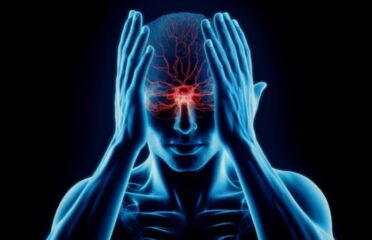Dandy Walker Syndrome
Overview

Dandy-Walker Syndrome (DWS) is a rare congenital condition that affects the cerebellum.
The cerebellum is a part of the brain located at the back that controls movement and balance. People with DWS may have underdeveloped or missing parts of the cerebellum, while other parts may be filled with fluid or cysts.
This can cause a range of symptoms such as coordination and balance difficulties, muscle stiffness, and developmental delays.
In most cases, hydrocephalus, a buildup of fluid inside the skull, causes the head to become larger than usual. Even though the condition is incurable, one can manage the symptoms with treatment, which can include surgical removal of cysts or the placement of a shunt to drain excess fluid.
Physical therapy and other supportive measures can also be helpful.
Symptoms
• Onset and Detection: Dandy-Walker Syndrome (DWS) symptoms typically manifest in infancy or early childhood. However, they may sometimes go unnoticed until later stages.
• Varied Presentation: DWS symptoms can emerge suddenly or gradually, exhibiting varying degrees of severity among individuals.
• Hydrocephalus symptoms include excessive brain fluid, irritability, vomiting, macrocephaly, delayed motor milestones, balance issues, and muscle stiffness.
• Motor Skill Challenges: Children with DWS may experience difficulty crawling, walking, and performing delicate motor tasks due to impaired muscle coordination.
• Visual Impairments: Vision problems may arise, affecting tasks like object manipulation or writing.
• Individual Variation: The presentation and severity of DWS symptoms can vary widely among affected individuals, necessitating personalized care approaches.
Causes & Risks
• Dandy-Walker Syndrome (DWS) is a congenital condition impacting the nervous and brain systems, characterized by abnormal cerebellum development.
• The precise cause of DWS remains unidentified. However, researchers suspect genetic factors and environmental influences may elevate the risk.
• DWS typically begins in the early stages of pregnancy, resulting in cerebellar malformation and fluid accumulation within the brain.
• From birth, developmental delays, motor coordination issues, balance impairments, and cognitive challenges persist into childhood.
• Early intervention, therapy, and consistent medical care are pivotal in alleviating symptoms and enhancing the quality of life for individuals with DWS.
• Children with Dandy-Walker Syndrome can lead productive lives with appropriate support and medical intervention.
Test & Diagnosis
• Prenatal tests like ultrasound, fetal MRI, and cell-free fetal DNA testing can diagnose Dandy-Walker Syndrome during pregnancy.
• Ultrasound detects brain abnormalities in fetuses, including those associated with Dandy-Walker Syndrome.
• Fetal MRI provides detailed visualization of the baby's organs, helping detect abnormalities without invasive procedures.
• Cell-free fetal DNA testing involves analyzing fetal DNA present in the mother's blood to screen for genetic abnormalities associated with Dandy-Walker Syndrome.
• Amniocentesis, a procedure to extract amniotic fluid, enables genetic analysis to identify chromosomal abnormalities, providing further diagnostic insights.
• After birth, testing can be done to confirm chromosome-related issues. It's essential to consult with a healthcare provider to determine the best diagnostic approach.
Treatment
• Dandy-Walker Syndrome (DWS) is often treated by surgically implanting a shunt to drain excess fluid from the brain and relieve pressure on the brain and skull.
• Surgery is usually recommended for most children with DWS, based on the severity of the condition and other medical factors.
• While shunt surgery can alleviate symptoms, its effectiveness may vary, and it may not be suitable for all cases of DWS.
• Shunt surgery timing is based on symptoms and health of the baby, with close monitoring for hydrocephalus signs.
• Children with shunts require lifelong management due to potential risks like infections and blockages.
• Babies without hydrocephalus signs may go home after birth. However, they need vigilant monitoring for symptoms, guided by the healthcare team.
Living With
Dandy-Walker Syndrome is an uncommon congenital brain abnormality that can cause various challenges for those affected.
The condition is marked by anomalies in the cerebellum and the fluid-filled spaces surrounding it, and its severity and impact can differ significantly among those with it.
People with this syndrome may experience physical symptoms like coordination difficulties, developmental delays, muscle stiffness or weakness, and neurological problems.
Further, it can lead to developmental and cognitive challenges that may necessitate additional support or specialized education.
Treatment strategies concentrate on managing symptoms, and surgeries may be necessary to address hydrocephalus or other brain structure abnormalities. Therapies like occupational therapy, physical therapy, and speech therapy can be helpful in enhancing motor skills, speech, and overall quality of life.
Ongoing monitoring by medical professionals is vital to keep track of the individual's progress, manage symptoms, and address any emerging medical issues.
Complications
• Dandy-Walker Syndrome manifests differently in individuals but commonly presents several complications and hurdles.
• A prevalent complication involves hydrocephalus, characterized by increased skull pressure, leading to symptoms like headaches, vomiting, irritability, and developmental delays.
• Abnormal brain development, particularly in the cerebellum, contributes to neurological issues such as motor skill impairments, coordination difficulties, muscle stiffness or weakness, and speech or language development delays.
• Individuals may experience cognitive challenges affecting learning, problem-solving skills, and overall cognitive development.
• Vision and hearing impairments, skeletal abnormalities, congenital heart defects, seizures, and psychosocial difficulties are also common occurrences.
• The syndrome's impact can vary widely, necessitating personalized care and management approaches tailored to individual needs.

The Content is not intended to be a substitute for professional medical advice, diagnosis, or treatment. Always seek the advice of your physician or other qualified health provider with any questions you may have regarding a medical condition.
Know more about
Our Healthcare Planner
Personal Health Planner at BNC is a support staff who listens to your concerns and connects you with a Neuro Care provider. They prioritize your needs and create a trusting relationship between you and the provider.
Three fundamental values we can assure you:
1. Personalized Healthcare.
2. Most advanced robotic therapies
3. Transparent pricing





